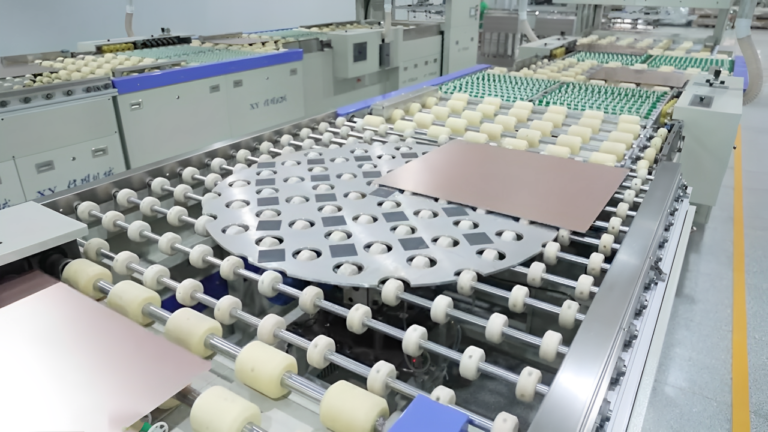More than 3000 square meters of warehouse, with a large stock
Light weight, small size, easy to air delivery
Injection molding department and machining department
24/7 one-on-one engineer service support
PCB Conveyor is an essential piece of equipment used in electronics manufacturing lines to transport printed circuit boards (PCBs) between different stages of assembly, inspection, testing, or cleaning. It plays a key role in automating production processes, improving workflow efficiency, and reducing manual handling, which minimizes the risk of damage to delicate components.
PCB conveyor is typically made of ESD-safe materials to protect sensitive electronic circuits from electrostatic discharge. They can be configured for different board sizes and customized for various transport lengths. Most conveyors offer adjustable speed, width settings, and height to fit seamlessly into SMT (Surface Mount Technology) production lines.
PCB conveyor comes in different types, such as link conveyors, buffer conveyors, inspection conveyors, and cooling conveyors, each serving a specific function. Many models include sensors, PLC control systems, and user-friendly interfaces for precise operation and integration with automated lines.
Overall, PCB conveyor is vital for maintaining a smooth, continuous, and efficient manufacturing environment.
1. What is a PCB Conveyor?
A PCB conveyor is an automated transportation system used to move printed circuit boards (PCBs) across different stages of production in an electronics manufacturing line. It is designed to safely carry PCBs to various assembly, inspection, testing, or cleaning stations without causing damage to sensitive components.
2. What types of PCB Conveyors are available?
There are several types of PCB conveyors, each designed for specific tasks:
Link Conveyors: Used to transport boards between different production processes.
Inspection Conveyors: Allow operators to inspect PCBs during or after assembly for quality control.
Buffer Conveyors: Temporarily hold PCBs to prevent congestion or delays in automated lines.
Cooling Conveyors: Used to cool down hot PCBs after soldering or other heat-intensive processes.
Cleaning Conveyors: Integrated into washing stations to transport boards through the cleaning process.
3. What are the main features of a PCB Conveyor?
Adjustable Speed: Allows operators to adjust the conveyor speed based on the type of PCB and the process being performed.
ESD-Safe Material: Most PCB conveyors are made from materials that prevent electrostatic discharge (ESD) to protect the sensitive circuits of PCBs.
Customizable Width and Length: Can be adjusted to accommodate different board sizes and layouts.
User-Friendly Control Systems: Many systems come with PLC (Programmable Logic Controller) interfaces that allow operators to monitor and adjust settings easily.
Modular Design: Many PCB conveyors offer a modular structure, enabling easy expansion or adjustment of the system based on evolving production requirements.
4. What is the importance of ESD (Electrostatic Discharge) protection in PCB Conveyors?
ESD protection is essential in PCB conveyors to prevent static electricity from damaging the sensitive electronic components on the boards. Most modern conveyors are made from ESD-safe materials, and some come with grounding systems to neutralize any static charges that may build up during operation.
5. How do I determine the right size of a PCB Conveyor?
To determine the correct size for your PCB conveyor, consider the following factors:
PCB Size: Ensure the conveyor can accommodate the largest size of PCB in your production line.
Production Speed: If your production process requires fast transport, opt for a conveyor with adjustable speed settings.
Available Space: Measure the area where you plan to install the conveyor to ensure it fits within the factory layout.
Weight Capacity: Ensure the conveyor can handle the weight of your PCBs, especially for large or heavy boards.
6. Can a PCB Conveyor be integrated with other automated systems?
Yes, PCB conveyors are designed to be integrated into larger automated production lines. They can be connected with robotic arms, pick-and-place machines, inspection systems, and other machinery. This integration allows for seamless transportation of PCBs through different stages without manual handling.
7. What maintenance is required for PCB Conveyors?
Regular maintenance is crucial for ensuring the longevity and efficiency of PCB conveyors:
Cleaning: Keep the conveyor belt clean from dust, dirt, and residue to prevent malfunctions and ensure smooth operation.
Lubrication: Lubricate moving parts regularly to reduce wear and tear.
Inspection: Routinely check for misalignments, wear on the belt, or any broken components.
Sensor and Control System Checks: Ensure that sensors, speed controllers, and PLC systems are functioning properly.
8. How can I prevent PCB damage during transportation on the conveyor?
To minimize the risk of damage during PCB transportation, consider these tips:
Use Anti-Slip and Soft Material: Ensure the conveyor uses non-abrasive materials that will not scratch or damage the PCB.
Correct Board Placement: Make sure PCBs are properly placed on the conveyor to avoid slipping or falling.
Adjust Conveyor Speed: Slow down the conveyor speed during delicate operations, such as inspection or handling fragile boards.
Use Guides and Supports: Employ guides, rails, or support structures to prevent PCBs from moving or tilting during transportation.
9. How does a PCB Conveyor improve efficiency in manufacturing?
PCB conveyors improve efficiency in manufacturing by:
Reducing Manual Handling: They automate the transportation of PCBs, reducing the need for manual labor and minimizing human error.
Increasing Throughput: With adjustable speeds and smooth transport, conveyors can speed up the production process.
Improving Consistency: Automated transport ensures that PCBs are consistently handled and positioned in the same way every time.
Enhancing Integration: PCB conveyors can be linked to other systems in the production line, enabling faster transitions between processes and better overall workflow.
102, No.14-1 Jixiang 3rd Road, Yixin Community, Longgang District, Shenzhen, Guangdong Province, China.
+ 86 181 8840 4906
eternal02023@gmail.com
We’re professional manufacturer of PCB equipment and consumable. We can give you the best advice for your requirements.
© All Rights Reserved.
WhatsApp us

Eternal Tech is committed to becoming an expert in PCB conveying systems.